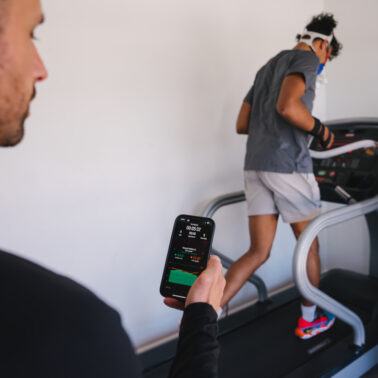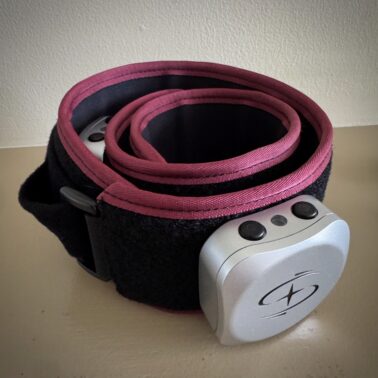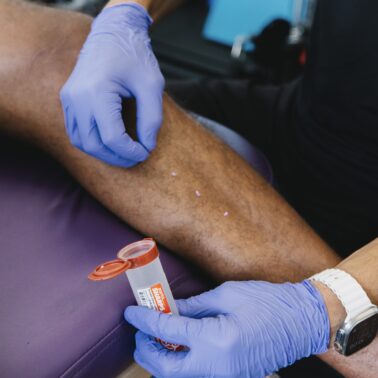Approximate Read Time: 12 minutes
“It’s not the final step that gives out — it’s the one before it that carries the hidden load during change of direction of multidirectional activities and is determined by true, quadriceps eccentric strength.”
What You will learn
- Eccentric strength, especially in the quadriceps, is essential for safe and efficient deceleration.
- Acceleration and deceleration involve fundamentally different biomechanics — and should be trained and tested as such.
- The triple hop test often fails to identify deficits in deceleration capacity and multi-step coordination.
- The penultimate step in change of direction absorbs more force than the final plant step and is critical for injury prevention.
- Compensating by overloading the uninjured limb post-surgery may contribute to the high rate of contralateral ACL injuries.
A Case Study in Modern Rehabilitation
In the high-stakes world of professional soccer, return-to-play (RTP) decisions are critical. Recently, I consulted on a case involving a Major League Soccer (MLS) player who, despite having a great return to play build up, was still struggling with high-intensity deceleration, change of direction (COD), and explosive jumping. One of the first questions I asked the physical therapist was, “What is his eccentric strength assessment?”
This article delves into WHY this was my first question. We discuss the biomechanical and neuromuscular distinctions between acceleration and deceleration, emphasizing the unique demands placed on the quadriceps during these movements. Drawing upon the extensive research of Dr. Damian Harper and others, we explore why eccentric strength is often the missing link in knee rehabilitation and how conventional tests like the triple hop may fall short in evaluating an athlete’s readiness for the dynamic demands of sport.
Biomechanics of Acceleration vs. Deceleration
Acceleration: The Propulsive Phase
Acceleration involves increasing velocity, primarily through concentric muscle contractions. The quadriceps, hamstrings, gluteals, and calf muscles work synergistically to propel the body forward. Key characteristics include:
- Muscle Action: Predominantly concentric contractions.
- Ground Reaction Forces (GRF): Lower peak forces with shorter ground contact times.
- Joint Kinematics: Extension at the hip, knee, and ankle joints.
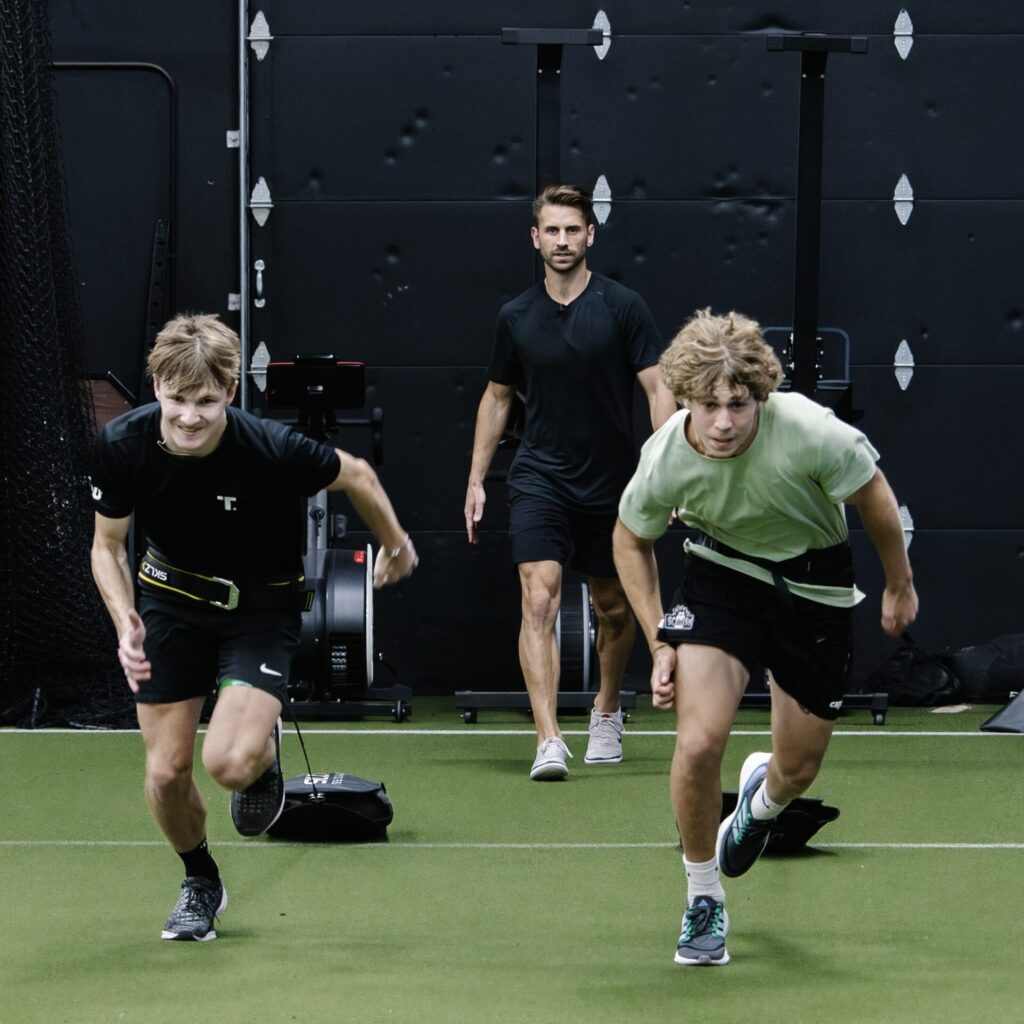
Deceleration: The Braking Phase
Deceleration, conversely, requires the body to reduce velocity, often rapidly. This phase is characterized by eccentric muscle contractions, where muscles lengthen under tension to absorb kinetic energy. Notable features include:
- Muscle Action: Predominantly eccentric contractions, especially in the quadriceps.
- Ground Reaction Forces (GRF): Higher peak forces with longer ground contact times.
- Joint Kinematics: Flexion at the hip, knee, and ankle joints to absorb impact.
Dr. Harper’s research highlights that during intense deceleration, the quadriceps undergo high-speed eccentric activation, with activity levels exceeding maximal isometric contraction. This underscores the significant neuromuscular demand placed on the quadriceps during braking movements.
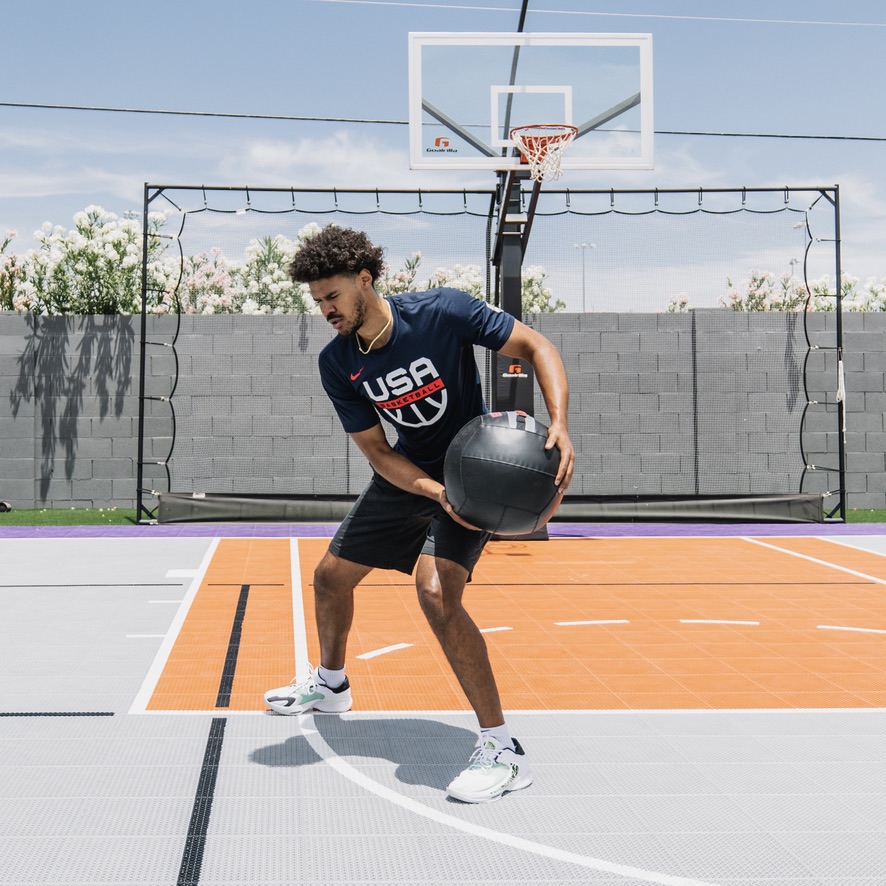
The Role of Eccentric Strength in Knee Rehabilitation
Eccentric contractions occur when a muscle lengthens under load, such as when lowering a weight or decelerating the body. These contractions are crucial for:
- Energy Absorption: Dissipating kinetic energy during landing or stopping.
- Joint Stability: Controlling joint motion and preventing excessive movement.
- Injury Prevention: Reducing the risk of strains and ligament injuries.
Eccentric Strength in Rehabilitation
After any knee injury, or lower body injury, restoring eccentric strength is vital. Studies have shown that eccentric-oriented strength training, including flywheel exercises, leads to better outcomes in leg strength, vertical jump ability, and hop tests compared to traditional strength training.
Neglecting eccentric training can leave athletes ill-prepared for the demands of deceleration and COD, increasing the risk of re-injury.
Limitations of the Triple Hop Test
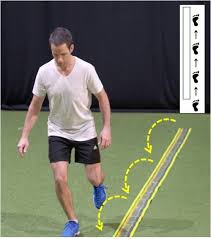
The single-leg triple hop test assesses an athlete’s ability to perform three consecutive hops on one leg, measuring distance to evaluate lower limb power and symmetry. While useful for assessing certain aspects of function, the test has limitations:
- Lack of Eccentric Assessment: The test emphasizes concentric power and does not adequately evaluate eccentric control during landing.
- Straight-Line Movement: It does not replicate the multidirectional demands of sport.
- Predictive Validity: Passing the test does not guarantee readiness for high-intensity deceleration or COD tasks.
Research indicates that hop tests, while reliable, may not effectively predict an athlete’s ability to handle the complex demands of sport-specific movements, particularly those involving rapid deceleration.
Comparative Analysis of Acceleration and Deceleration
Electromyography (EMG) studies reveal distinct differences in muscle activation during acceleration and deceleration:
- Acceleration: Higher activation of the gluteals and hamstrings to generate forward propulsion.
- Deceleration: Increased activation of the quadriceps and hamstrings to absorb impact and stabilize joints.
Dr. Harper’s findings indicate that during deceleration, quadriceps activity can exceed maximal isometric levels, highlighting the intense demand placed on these muscles.
Deceleration involves higher GRFs compared to acceleration, necessitating greater muscular effort to control and dissipate forces. This increased load underscores the importance of eccentric strength in managing the mechanical demands of stopping and changing direction.
The Hidden Force Generator — The Penultimate Step in Change of Direction
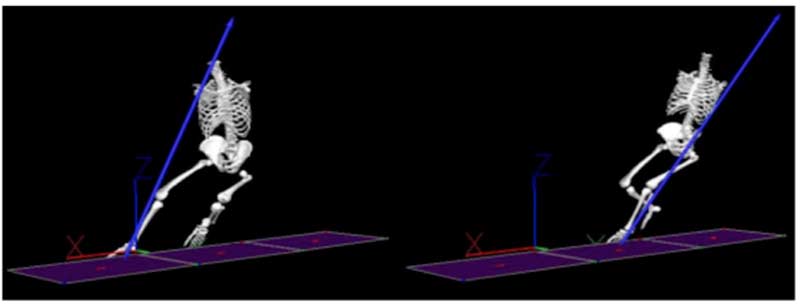
When most think of cutting, pivoting, or changing direction, attention immediately focuses on the plant leg—the final step that pivots the body into a new trajectory. But growing research has exposed a crucial truth: it’s the penultimate step—the second-to-last foot contact—that often carries the highest force loads and plays a foundational role in safe and effective deceleration.
Key Findings from Research
Several biomechanical studies have shown that:
- Jones et al. (2016) demonstrated that during COD tasks (especially ≥90° turns), the penultimate step often generates greater horizontal braking forces than the final plant step.
- Dos’Santos et al. (2018) found that athletes who utilize a more effective penultimate step—marked by a lower center of mass, greater hip and knee flexion, and higher eccentric quadriceps activity—showed reduced knee valgus and joint loading at the final step, making the movement both more efficient and safer.
- EMG studies have revealed higher eccentric quadriceps activation during the penultimate step, aligning with the need to absorb and redirect momentum before the body reaches the plant foot.
“The penultimate foot contact plays a preparatory role by facilitating effective braking and repositioning of the center of mass.”
— Jones et al., 2016. Br J Sports Med
Why the Penultimate Step Matters in Rehab
In rehab, especially following ACL reconstruction or patellar tendon injuries, athletes are often coached and tested on cutting and COD using a plant-and-go strategy. However, if rehab drills or RTP criteria neglect the load and timing demands of the penultimate step, several critical issues arise:
- The quadriceps must eccentrically control rapid deceleration at this step—something rarely assessed or trained in isolation.
- Athletes may over-rely on the final pivot leg, increasing knee joint torque and injury risk if eccentric quad strength is lacking.
- Traditional RTP tests (e.g., triple hop) completely overlook this stepwise sequence and joint loading strategy.
Think of COD like trying to park a speeding car in a tight spot:
- The penultimate step is the brake, slowing the car.
- The final step is the steering wheel, redirecting the body.
Without an effective brake, the steering becomes unpredictable and dangerous. Similarly, if the penultimate step is undertrained or weak, the final cut becomes riskier, especially for a healing knee.
Compensation and Consequence — When Fear Shifts Load to the Penultimate Step
One of the most important, yet underappreciated, clinical observations in post-operative knee rehab is how fear of reloading the injured limb often leads to compensatory movement patterns. In particular, athletes may instinctively shift braking demands to the contralateral leg during deceleration and change of direction (COD) tasks—especially during the penultimate step.
Athlete Behavior: Fear of the Final Step
After ACL or meniscus repair, many athletes unconsciously protect their surgical limb by:
- Underloading during the final plant step (i.e., surgical side).
- Overloading the penultimate step (often contralateral limb).
- Displaying increased ground contact times, trunk lean, or knee stiffening when landing on the previously injured leg.
These alterations may not show up in isolated tests (like single-leg hop symmetry) but become apparent during high-speed COD drills.
The Chain Reaction: How Compensation Fuels Contralateral Risk
When the penultimate step becomes the “new braking leg”, this creates:
- Elevated eccentric demands on the contralateral quadriceps and hamstrings.
- Greater ground reaction forces absorbed per step by the uninjured limb.
- Higher neuromuscular fatigue on that side, especially over repeated high-intensity movements.
This phenomenon is one explanation for the alarming data on contralateral ACL injury following return to sport:
Research Inisght
A meta-analysis by Wiggins et al. showed that contralateral ACL tears occur at nearly the same rate as re-injury of the surgical limb within 2 years post-ACLR—suggesting global biomechanical or neuromuscular asymmetries are to blame, not just local tissue healing. Here is an example of how this might play out:
- COD Drill at 100% Speed
- Penultimate step is right leg (uninjured).
- Final plant step is left leg (surgical).
- Athlete avoids deep flexion or full weight acceptance on left.
- Right leg absorbs the majority of braking force.
- Right quadriceps fatigues faster and becomes more exposed to high-risk mechanics:
- Reduced knee flexion angles.
- Elevated valgus torque.
- Lower trunk control due to imbalance in eccentric capacity.
Over time and under fatigue, the uninjured limb becomes the overused limb—and potentially, the next surgical case.
Rehab Implication: Symmetry ≠ Readiness
Passing RTP tests with 90%+ limb symmetry in strength or hop distance does not guarantee symmetrical loading strategies during complex movements. This is where embedded testing, COD biomechanics, and movement audits under game-like speeds become critical.
Practical Suggestions
- Use 3D motion analysis or video review during COD to identify limb avoidance strategies.
- Implement drills where the athlete must cut off either leg randomly to assess reactive loading tendencies.
- Train braking skills on both legs under fatigue, not just the surgical limb.
- Use tools like force plates or wearable sensors to measure asymmetries during the penultimate step and final step.
Key Takeaway: Protecting One Limb Shouldn’t Sacrifice the Other
In performance therapy, protecting the repaired knee cannot come at the cost of overloading the opposite limb. If we fail to identify and correct compensation during deceleration strategy, particularly at the penultimate step, we risk solving one problem only to create another—the perfect storm for contralateral ACL or meniscal injuries.
Integrating Eccentric Training into Rehabilitation Protocols
To effectively evaluate and train eccentric strength, practitioners can utilize:
- Isokinetic Testing: Measures muscle strength at constant speeds, allowing for assessment of eccentric capabilities.
- Flywheel Devices: Provide variable resistance, emphasizing eccentric loading during exercises.
- Force Plates: Analyze landing mechanics and force absorption during deceleration tasks.
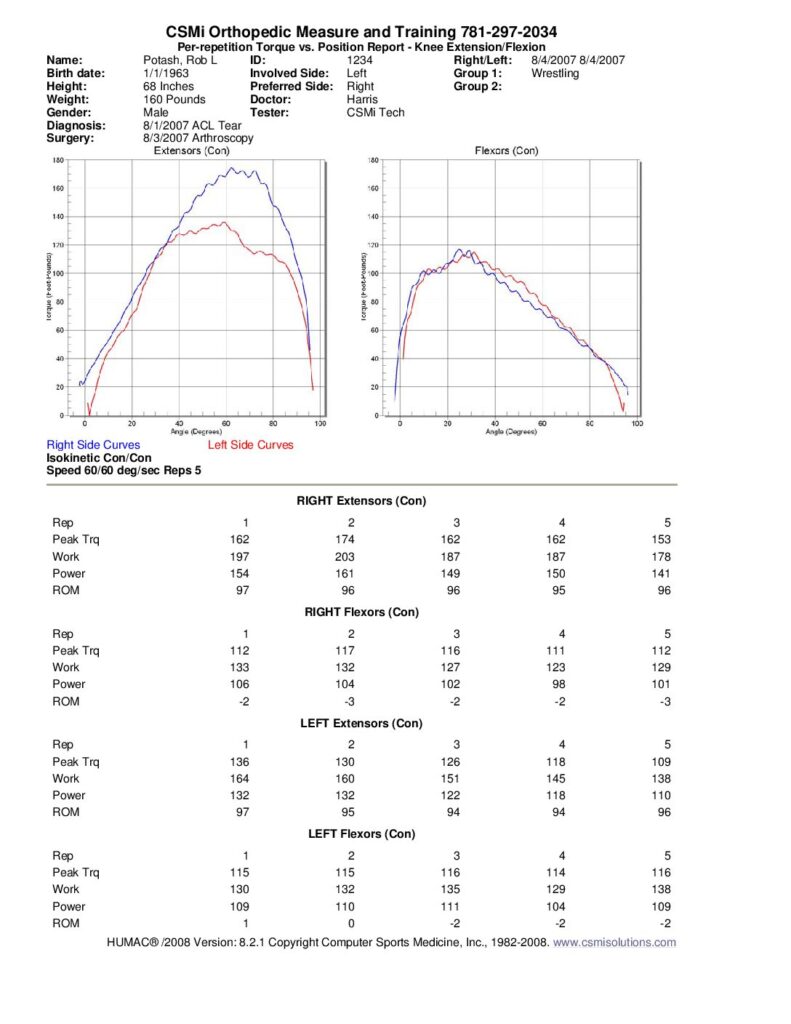
Training Strategies
Incorporating eccentric-focused exercises into rehabilitation can enhance deceleration capacity:
- Nordic Hamstring Curls: Target eccentric strength in the hamstrings.
- Fake Medicine Ball Tosses: Fast movements like fake med mall slams or chops can help create the impulse to target the specific shapes and angles of deceleration
- Eccentric Squats: Emphasize controlled lowering phases to build quadriceps strength.
- Yielding Isometrics: Develop connective tissue strength through the means of holding a specific position with a near maximal load.
- Video Analysis: using video during change of direction activities can help better understand the kinematics of the penultimate step
Implementing these strategies can bridge the gap between traditional strength training and the specific demands of sport, reducing the risk of re-injury and enhancing performance.
Rethinking Return-to-Play Assessments
The case of the MLS player underscores the necessity of comprehensive RTP evaluations that go beyond traditional tests like the triple hop. Recognizing the distinct demands of deceleration and the critical role of eccentric strength is paramount in preparing athletes for the realities of sport.
By integrating eccentric-focused assessments and training into rehabilitation protocols, practitioners can ensure athletes are not only cleared to play but are truly ready to perform at their highest level.
References
Wiggins AJ, Grandhi RK, Schneider DK, Stanfield D, Webster KE, Myer GD. Risk of secondary injury in younger athletes after anterior cruciate ligament reconstruction: A systematic review and meta-analysis. Am J Sports Med.2016;44(7):1861-1876. doi:10.1177/0363546515621554
Dos’Santos T, Thomas C, Comfort P, Jones PA. The role of the penultimate foot contact during change of direction: Implications on performance and risk of injury. Strength Cond J. 2017;39(1):45-52. doi:10.1519/SSC.0000000000000284
Dos’Santos T, Thomas C, Jones PA, Comfort P. The effect of angle and velocity on change of direction biomechanics: An angle-velocity trade-off. J Sports Sci. 2018;36(11):1232-1239. doi:10.1080/02640414.2017.1376756
Harper DJ. Neuromuscular determinants of horizontal deceleration ability in team sport athletes: Performance and injury risk implications [PhD dissertation]. University of Central Lancashire; 2022. Available from: https://www.researchgate.net/publication/366836789
Harper DJ. High eccentric demands and mechanical loading during horizontal deceleration: Training and monitoring implications. Strength Cond J. 2023;45(2):23-32. doi:10.1519/SSC.0000000000000698
Arumugam A, Häger CK. Thigh muscle co-contraction patterns in individuals with anterior cruciate ligament reconstruction, athletes, and controls during a novel double-hop test. Sci Rep. 2022;12(1):1-10. doi:10.1038/s41598-022-12436-6
Marot J, Lambert C, Doussot M, et al. Effects of eccentric-oriented strength training on return to sport criteria in late-stage anterior cruciate ligament (ACL)-reconstructed professional team sport players. Res Sports Med. 2023:1-13. doi:10.1080/15438627.2023.2220701
